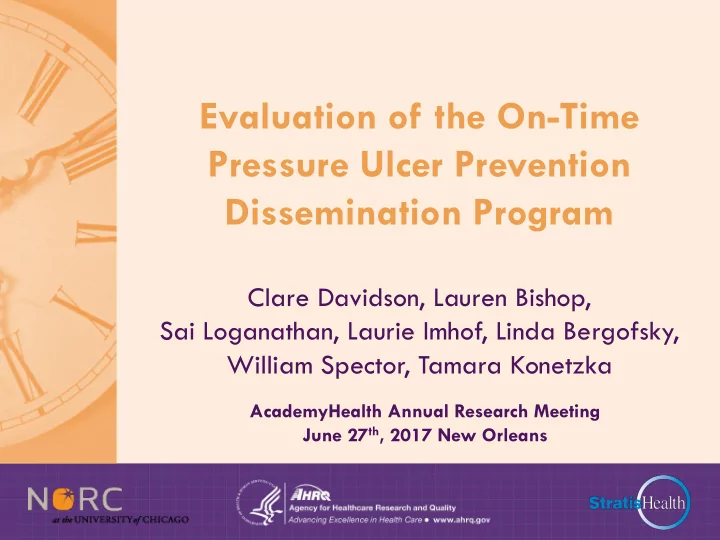

Evaluation of the On-Time Pressure Ulcer Prevention Dissemination Program Clare Davidson, Lauren Bishop, Sai Loganathan, Laurie Imhof, Linda Bergofsky, William Spector, Tamara Konetzka AcademyHealth Annual Research Meeting June 27 th , 2017 New Orleans
Pressure Ulcers (PrUs) and Health Information Technology (HIT) ► PrUs increase patient morbidity and mortality and are costly to patients and the health care system. ► Opportunities exist for using HIT to help alert staff of PrU risk and inform clinical decision-making. Right Right Right Effective Data People Time Support 2
The Nursing Home Context Patients Low Lengthy Slow to Bulk of with High Direct Adopt Margins- Patient Number Electronic Shrinking Care by Stays of PrU Health Finances, Nurses Risk Records Increasing and Aides Factors (EHR) Demands 3
On-Time Program ► The Patient Safety Program for Nursing Homes: On-Time was developed by the Agency for Healthcare Research and Quality (AHRQ). Effective Right Right Right and Safe Data People Time Care Website: https://www.ahrq.gov/professionals/systems/long-term- care/resources/ontime/index.html 4
On-Time Program ► The Patient Safety Program for Nursing Homes: On-Time was developed by the Agency for Healthcare Research and Quality (AHRQ). Data on Adverse Frontline Weekly Risk Event Staff and Early Factors Decrease Facilitation Website: https://www.ahrq.gov/professionals/systems/long-term- care/resources/ontime/index.html 5
On-Time PrU Prevention Reports ► Based on multiple sources of data from the medical record, particularly certified nursing assistant (CNA) charting. ► Include: Nutrition Risk, Weight Summary, PrU Trigger Summary, and Risk Change ► Provide a weekly snapshot at the resident, unit, or facility level to identify risk for PrU development. 6
On-Time PrU Prevention Facilitation ► A trained facilitator is utilized to help staff understand the reports and to guide integration of reports into day-to-day clinical decision-making. 7
The Current Study Core Research Questions: What is the effect of On- 1. Time on pressure ulcer incidence? AHRQ What factors were Funder 2. associated with facilities’ Disseminate ability to successfully and Evaluate implement On-Time? What are the barriers and NORC 3. at the Stratis expediters to disseminating University Health of Chicago Facilitators Evaluator On-Time? 8
Mixed Methods Approach Quantitative: Core Research Questions 1&2 ► Longitudinal pre-post analysis. Treatment facilities only. ► Pre-post difference-in-differences analysis. Treatment and matched control facilities. Qualitative: Core Research Questions 2&3 ► Content analysis of facilitator-collected encounter notes. ► Content analysis of nursing home and facilitator discussions. Mixed Methods: Core Research Questions 2&3 ► Examination of factors associated with success. 9
Mixed Methods Approach Quantitative: Core Research Questions 1&2 ► Longitudinal pre-post analysis. Treatment facilities only. ► Pre-post difference-in-differences analysis. Treatment and matched control facilities. Qualitative: Core Research Questions 2&3 ► Content analysis of facilitator-collected encounter notes. ► Content analysis of nursing home and facilitator discussions. Mixed Methods: Core Research Questions 2&3 ► Examination of factors associated with success. 10
Participating Facilities (n=41) PROFIT STATUS FIVE-STAR RATING 2 Gov't For-profit 3 5 4 Non-profit LOCATION BED COUNT West South Northeast >201 0-100 101-200 Midwest 11
The PrU Measure of Interest ► Captures percentages of long-stay, high- risk residents with Stage II-IV PrUs. • Long Stay = More than 100 cumulative days in the facility. • High-Risk = Impaired bed mobility or transfer; Comatose; Malnutrition. 12
Preliminary Study Results Overall High-risk Pressure Ulcer Rate 6% 5.01% 5% 3.94% 3.90% 4% 3.72% 2.87% 3% 2% 1% 0% Q1 2016 Q2 2016 Q3 2016 Q4 2016 Q1 2017 Q1 2016 Q2 2016 Q3 2016 Q4 2016 Q1 2017 13
Qualitative Methods ► ‘Encounter Notes’ collected over a 12 month period. ► Homes categorized according to time to implementation. ► NVivo 11 used to analyze the percentage coverage for success- and challenge- related codes by time to implementation. • Percentage coverage = Percentage of each code for which a group is ‘responsible’; has limitations. 14
Challenge and Success-Related Coding by Time to Implementation Challenge Codes Success Codes 100% 100% 90% 90% 80% 80% 70% 70% 60% 60% 50% 50% 40% 40% 30% 30% 20% 20% 10% 10% 0% 0% <6mo: n=19; 6-12mo: n=12; Did Not Complete: n=21 <6mo 6-12mo Did Not Complete 15
Time Required to Implement Challenges: Limited staff time EHR functionality Having the right data Expeditors: Figuring out workflow Team communication Understanding how to use the EHR 16
Conclusions ► Associated with reduced rates of pressure ulcer incidence on average. ► Timely implementation was contingent upon nursing home organizational capacity to adapt workflow and utilize EHR. ► Potential for real impact in the right setting. 17
Limitations ► Initial pre-post PrU measure findings may actually reflect a secular trend. ► Analysis of qualitative data continues and different patterns may emerge. 18
Next Steps ► Incorporating Minimum Data Set (MDS) data from CMS. ► Difference-in-differences analysis. ► Further qualitative analysis of encounter notes as well as nursing home and facilitator discussions. ► Mixed-methods analysis to determine factors associated with success. 19
Questions? Contact: Davidson-Clare@norc.org
Recommend
More recommend